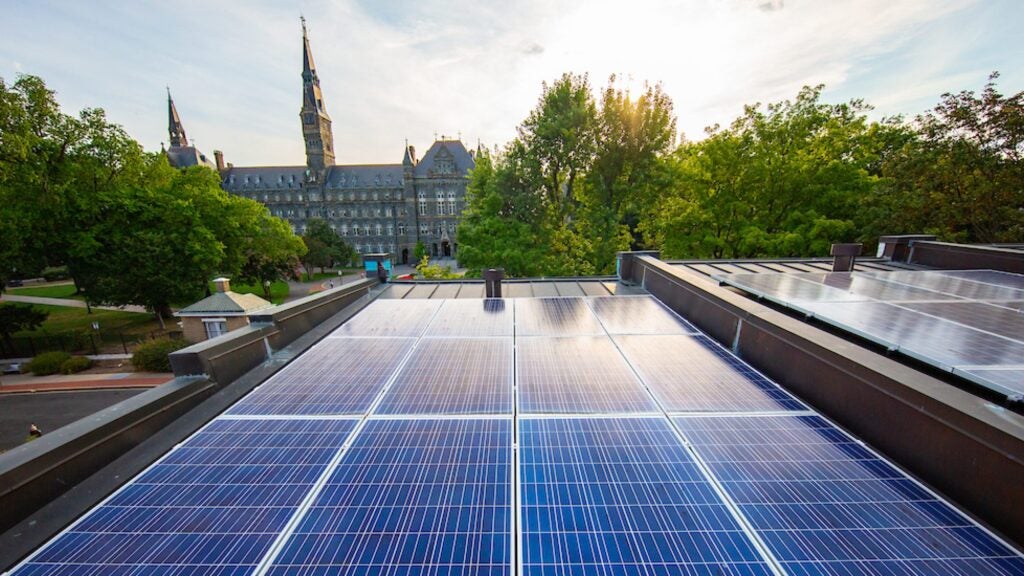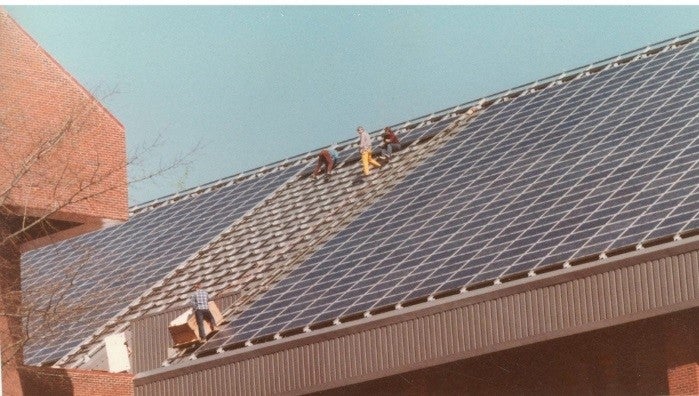Projects and Responsibilities

Projects
At any time, our department is engaged in a variety of projects that focus on identifying and addressing system deficiencies, increasing overall efficiency, and expanding our infrastructure and production to deal with growing campus demand.
Thermal Storage Tank
Beneath the Leavey Center lies a storage reservoir that holds approximately 2.2 million gallons of chilled water. The tank is connected by piping manifolds to the University’s pipe system and a 4,000 gallon per minute remotely operated pump.
Sensors throughout the tank allow us to see the water temperature at every level. The tank is charged by the chillers at night when campus cooling demand dips.
To draw from the tank, tank water is pumped to join the chilled water pumping out to campus from the Central Plant. The thermal storage tank can deliver about 1,000 tons of cooling, over about eight to ten hours, before it needs to be replenished.
Smart Meter Technology
Georgetown owns and maintains a 13,800-volt electrical distribution system to supply electricity to 60 campus buildings, which annually consume more electricity than around 13,000 average U.S. homes. By integrating smart meter technology, we are able to track real-time energy consumption at the building level. This allows us to analyze consumption trends and identify opportunities for significant energy savings.
Standby Generator Emission Reduction
Georgetown Campus has 33 standby emergency generators throughout campus that support vital life safety equipment in buildings. We are implementing new generator testing procedures and design requirements that will limit emissions from these generators.
Intercultural Center’s 300kW Photovoltaic Rooftop Array

The photovoltaic array at Georgetown University was installed in the summer of 1984, spanning almost 36,000 square feet on the roof of the Intercultural Center (ICC). At the time, it was the largest rooftop array of its kind. The system was designed to produce 300 kW under standard test conditions of 1,000 watts per square meter (W/m2) at 28° C.
The inverter system or power conditioner operated above 95% efficiency in producing three-phase 480/277-volt alternating current power to the building. The unit turned itself on when there was sufficient light for stable parallel operation and then off once below this threshold. The early years saw as high as 300 kW peak generation and about 360,000 kWh per year.
In December of 2011, after supplying twenty-seven years of solar power to the ICC, the photovoltaic array was shut down due to deterioration. The next step is to dismantle and replace it, but that would require substantial effort and funding. For now, it rests quietly on the roof of the ICC, a stark symbol of Georgetown’s commitment to sustainability and renewable power. From installation to shutdown, the array generated a total of 5.8 million kWh.
Fuel Cell Bus Program (Advanced Vehicle Development Team)
The Georgetown University Fuel Cell Bus Program began in 1983 and was concluded in 2011. A fuel cell bus is an all-electric hybrid bus powered by a combination of a fuel cell and batteries. The fuel cell, which replaces the gasoline or diesel engine in a typical hybrid vehicle, generates electricity through chemical reaction fueled by oxygen and hydrogen. Using hydrogen and oxygen generates no pollutants as only water is the by-product of the process. The hydrogen for the fuel cell can be stored on the vehicle in canisters or generated on demand through extraction from another fuel type (e.g., methanol). Methanol, also called wood alcohol, is rich in hydrogen which makes it a good fuel source for a fuel cell system. It is a liquid which simplifies refueling.
Georgetown had three generations of fuel cell bus development projects, all supported by grants and contracts from the Federal Transit Administration (FTA) and the U.S. Department of Energy (DOE), with supporting funds from other interested federal agencies.. Five methanol-fueled fuel cell buses were built which proved efficient and quiet and functioned with near zero emissions.
In 1983, Georgetown managed a feasibility study conducted by Los Alamos National Lab and sponsored by the U.S. Department of Transportation (DOT) that concluded transit buses were ideal vehicles for fuel cell power. As a result, two 25 kW phosphoric acid-fuel cell (PAFC) systems (fuel cells are characterized by the type of catalyst used) and low temperature steam reformers for methanol were developed to prove fuel cell systems could power a 30foot transit bus.
In 1991, Georgetown was awarded contracts to build three methanol-powered fuel cell hybrid electric 30foot buses (Generation I). The first bus rolled out on Earth Day 1994, and the remaining two in 1995. Each bus was outfitted with a 50 kW PAFC.
Georgetown University was awarded a grant by the FTA in 1994 to build two larger (40ft) fuel cell buses (Generation II). The buses were Nova Bus models, popular in the mid1990s. BAE Systems provided the hybrid electric drive system. The first bus had a 100 kW PAFC fuel cell from United Technology Corporation and started running in 1998. The second bus, sent out in 2001, had a 100 kW Proton Exchange Membrane (PEM) fuel cell provided by XCellSys, a German fuel cell company.
In 2005, development began on a third generation methanol fuel cell system with the limited funding remaining on the grant. Georgetown awarded contracts to the Electric Power Research Institute and two German companies, the Center for Solar and Hydrogen Research (ZSW) and NuCellSys (formerly XCellSys). The team developed a fuel cell system and an onboard methanol reformer that was much smaller and lighter. While the previous system weighed around 4,000 pounds, this system weighed less than 1,000. It was packaged to fit the same space a diesel engine on a standard transit bus would, making it about a sixth of the volume of the previous system. Testing of the new system was successful, though some technical issues remained when funding ran out in 2011. The system was left in place at ZSW’s test laboratory in Germany. In September 2011, Georgetown submitted a final report on the history and the state of the technology of the methanol fuel cell bus project.
